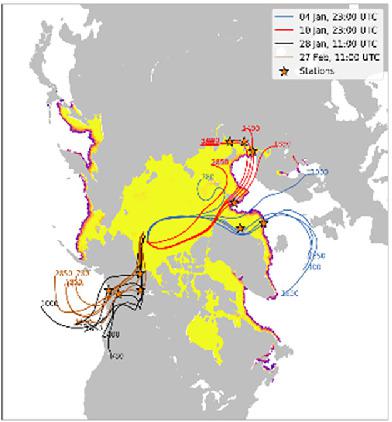当前位置:
X-MOL 学术
›
Q. J. R. Meteorol. Soc.
›
论文详情
Our official English website, www.x-mol.net, welcomes your
feedback! (Note: you will need to create a separate account there.)
Following moist intrusions into the Arctic using SHEBA observations in a Lagrangian perspective
Quarterly Journal of the Royal Meteorological Society ( IF 3.0 ) Pub Date : 2020-06-19 , DOI: 10.1002/qj.3859 S. Mubashshir Ali 1, 2, 3 , Felix Pithan 1
Quarterly Journal of the Royal Meteorological Society ( IF 3.0 ) Pub Date : 2020-06-19 , DOI: 10.1002/qj.3859 S. Mubashshir Ali 1, 2, 3 , Felix Pithan 1
Affiliation

|
Warm and moist air masses are transported into the Arctic from lower latitudes throughout the year. Especially in winter, such moist intrusions (MIs) can trigger cloud formation and surface warming. While a typical cloudy state of the Arctic winter boundary layer has been linked to the advection of moist air masses, direct observations of the transformation from moist midlatitude to dry Arctic air are lacking. Here, we have used observations from the Surface Heat Budget of the Arctic Ocean (SHEBA) project to compile Eulerian observations along the trajectories of warm and cold air masses in a Lagrangian sense, showing the cooling and drying of air masses over sea ice and moistening over the open ocean. Air masses originating mostly over open water generate cloudy conditions over the observation site, whereas air masses originating over continents or sea ice generate radiatively clear conditions. We recommend using our case‐studies and the method of linking expeditions to station soundings via back‐trajectories for modelling work in future campaigns.
中文翻译:

使用拉格朗日视角的SHEBA观测结果,对潮湿的北极进行入侵
全年,温暖潮湿的空气从低纬度地区被运送到北极。尤其是在冬天,这种潮湿的入侵(MIs)会触发云的形成和表面变暖。虽然北极冬季边界层的典型多云状态与湿气团的平流有关,但缺乏从湿中纬度到北极干空气转变的直接观察。在这里,我们使用了北冰洋表面热收支(SHEBA)项目中的观测值,沿拉格朗日意义上的冷热空气轨迹编制了欧拉观测值,显示了海冰上空气团的冷却和干燥以及湿润在远洋。主要来自开放水域的气团在观测点上产生了多云的条件,而来自大陆或海冰的气团则产生辐射清晰的条件。我们建议使用案例研究和通过后向轨迹将远征与测站联系起来的方法,以便为以后的战役建模。
更新日期:2020-06-19
中文翻译:

使用拉格朗日视角的SHEBA观测结果,对潮湿的北极进行入侵
全年,温暖潮湿的空气从低纬度地区被运送到北极。尤其是在冬天,这种潮湿的入侵(MIs)会触发云的形成和表面变暖。虽然北极冬季边界层的典型多云状态与湿气团的平流有关,但缺乏从湿中纬度到北极干空气转变的直接观察。在这里,我们使用了北冰洋表面热收支(SHEBA)项目中的观测值,沿拉格朗日意义上的冷热空气轨迹编制了欧拉观测值,显示了海冰上空气团的冷却和干燥以及湿润在远洋。主要来自开放水域的气团在观测点上产生了多云的条件,而来自大陆或海冰的气团则产生辐射清晰的条件。我们建议使用案例研究和通过后向轨迹将远征与测站联系起来的方法,以便为以后的战役建模。











































 京公网安备 11010802027423号
京公网安备 11010802027423号